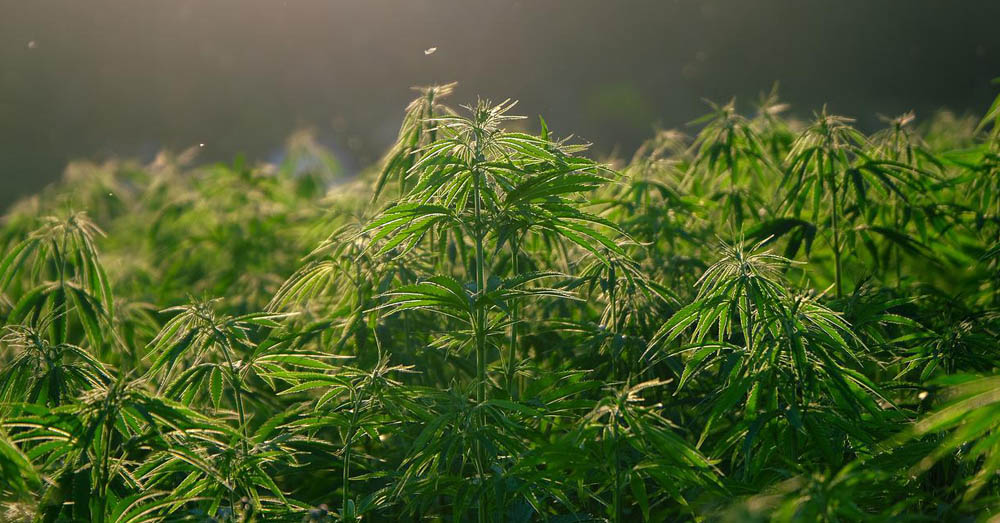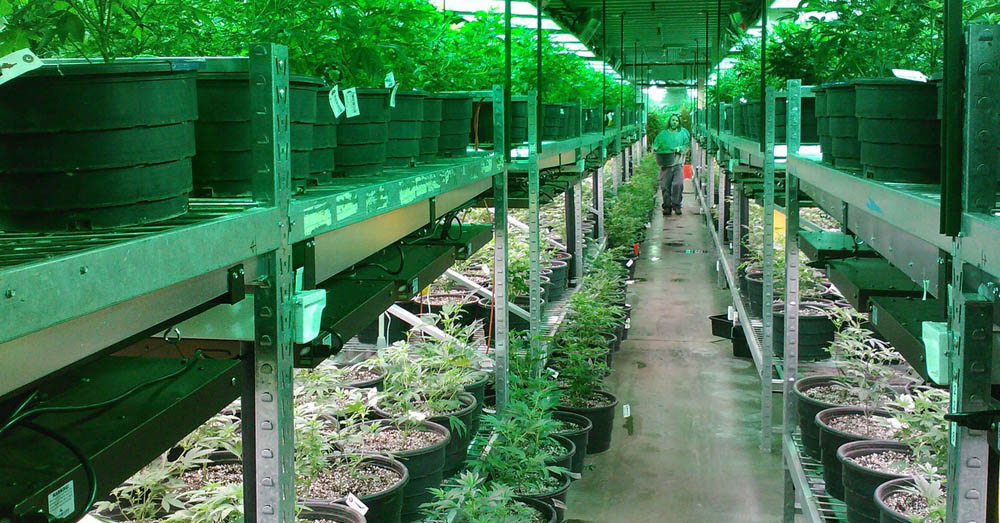Cannabis plants can also experience stress as much as you do.
In some cases, they cannot survive the severe heat stress. Thus, they wither and die.
If you are using and growing Cannabis, you should know all about the Cannabis heat stress symptoms and how to prevent it.
What Is Cannabis Heat Stress?

Cannabis heat stress is a complex issue that occurs when the Cannabis is maturing in an environment with extreme heat, to the extent that the plant struggles to cope with biochemistry.
The foundational cell functions will be challenging as the grow room temperatures rise.
Thus, plant health will deteriorate until the heat stress is under control.
If you cannot treat heat stress on time, expect a low-quality harvest, or worse, Cannabis plants will not be able to survive.
What Are the Symptoms of Cannabis Heat Stress?
The symptoms of Cannabis plants undergoing heat stress and heat wave are noticeable depending on the stage of the plants and the causes of heat stress.
The symptoms that will occur in the flowering phase will differ in the vegetation phase and the risk in these stages.
You should recognize what heat stress looks like, so you can nip it in the bud before it grows and damages your other plants.
Here are the key symptoms that will help you diagnose heat stress.
Cannabis Seedling Stage
- The seedling will have slow growth.
- The leaves look pale and dehydrated.
- Seedlings are more at risk and have insufficient strength. In some cases, they eventually die.
Vegetative Stage
- Withering and curling leaf tips upwards of the leaves
- There are brown and dry spots on the leaves
- The tips of the leaves may appear burnt and curled.
Flowering Stage
- There is the yellowing and bleaching of the canopy leaves.
- The formation of foxtails or the unusual growth of new buds on top of the mature buds.
- Abnormal amounts of white pistils before harvest (NOTE: Unfortunately, the dreadful heat stress in flowering Cannabis plants can have permanent effects.)
Why Do Cannabis Plants Overheat?
Cannabis heat stress had various contributing factors.
It can be due to heat stress or bad environmental conditions that may cause other problems such as lack of nutrients.
Either way, the heat problem is quite tough to treat.
#1 Low Humidity
When cannabis plants are experiencing heat stress due to high temperatures, they organically fight stress by increasing their transpiration.
This process deduces that water needs to be available in the plants’ environments and their root zone to conduct transpiration.
However, in low-humidity environments, transpiration is tougher.
#2 Too Much Light Exposure
When you position the cannabis plants in direct sunlight, you will notice that the plant growth will stop, along with the fading out near the tip.
Cannabis plants can endure particular levels of light intensity before it becomes overwhelming.
If you have excessive heat and light, with the PPFD levels above 1300-1500, anticipate problems, except if you have carbon dioxide enhancement.
Inspect with your light manufacturer for the suggested hanging heights and to secure that you are not compromising your plants.
Disproportionate PPFD or light intensity, together with heat stress, will more likely cause a sharp end to any growth in your room.
It will even negatively affect your harvest, both in quality and quantity.
#3 Nutrient Burn
If you notice cannabis heat stress, you can still remedy the issue and manage the problem if the cannabis plants are in good health under light stress.
But if the cannabis plant deteriorates due to nutrient burn, this will substantially affect the potential of the plants to handle further damage that follows heat stress.
#4 Equipment Failure
The damage to your grow room temperature sensor that handles the oscillating fans and air conditioning may cause serious problems.
All your equipment in your grow tent should be securely checked and should be in working order.
Other growers replace paraphernalia, such as carbon filters and pH meters.
#5 Poor Ventilation
Insufficient ventilation may result in substandard levels of grow room extraction.
You can have proper ventilation by eliminating heat and ensuring that the grow space has an adequate supply of fresh air photosynthesis.
Always ensure that your exhaust system and extraction fan are sufficient and work well for your grow room, and replace it if needed.
Unfortunately, your fan will not be effective enough for temperature control in countries with hot climates, with an outside air temperature of 35ºC.So the alternative is to use air conditioning.
How Can I Prevent Cannabis Heat Stress?
You don’t have to panic if you notice heat stress stage symptoms. For you can still find a remedy to treat this problem.
Here are ways on how you can solve indoor and outdoor heat stress:
Indoor Heat Stress
Earlier in the article, we listed varying symptoms in the seedling, vegetative, and flowering stages.
Growing Cannabis indoors can be tricky or undemanding because you can control the grow room environment.
Indoor growers usually install air conditioning or extraction fans to manage grow room temperatures.
Still, many factors cause heat stress, and you must handle it quickly to prevent further damage to plasma membranes and cell walls.
Seedling
Growing seedlings should not be under too much light to release a lot of heat waves.
You can station a dimmer to control your indoor plants’ strength of grow light.
You can also add distance between the seedlings and the light source to produce less heat and light stress and protect young Cannabis plants.
Hydration is critical, so you must water your seedlings twice a day but do it sparingly. This will significantly help in reducing heat stress.
Vegetative
In this stage, the plants can produce plenty of leaves that will undergo photosynthesis.
During this process, the relative humidity drops, and leaves can lose water that will tend to run dry.
To avoid this, put large containers of water inside the grow room, as the water will organically evaporate to stabilize the dry air with moisture.
Control the heat by placing heat extraction hoods that direct the hot air out of your grow room.
Remember to keep the grow lights about 24 to 30 inches from the Cannabis canopy.
Consistently water your Cannabis at least once early morning or the evening when the potting soil is cooled down.
Flowering
The stretching in the flowering phase can bring a risk of heat stress since the flowering Cannabis extends facing the light source, exposing it to light pressure and heat damage.
If you have adequate height clearance, modify the distance between the plant canopy and the radiant heat.
To prevent the plant’s unmanageable height at its ultimate flowering stage, consider low-stress training in your entire plant.
Again, ensure that the plants are hydrated and that your ventilation equipment, such as air conditioning and extraction fan, are in check.
Even the low humidity and listless heat buildups can cause heat problems.
Outdoor Heat Stress
Controlling heat stress outdoors is similar to indoor growing.
But, they vary in the natural environment, as this will be harder to administer because the outdoor environment will be out of your control.
Seedling
For outdoor growers who grow marijuana plants in a hot climate, you should know by now that it’s better to pick strains of Cannabis that are heat-resistant.
Plant your seedling outdoors in pots, so you can easily recognize the heat stress symptoms.
Then, you can relocate your seedlings to a more relaxed zone with shade and fresh air.
Outdoor plants are also vulnerable to swiftly losing water due to direct light exposure. Thus, watering your plants is a must. You can do this twice daily to prevent heat-stressed buds.
TIP: Do not use black pots because this will store more heat and high humidity.
Vegetative
In this phase, Cannabis plants have plenty of leaves and a higher surface area for moisture loss when the humidity plummets and the heat is unmanageable.
To remedy humidity issues, you can work with the weed seasons.
Timing is everything. Plant at the most precise time wherein your vegetative phase will correspond to the acceptable moisture levels.
To test if there’s water loss from your potting soil. You can place a finger into the ground, and if it feels dry, your soil water is declining, and plants are dehydrated.
Water your Cannabis plants at least once a day and relocate the plants into the shade when you first spot signs of heat-stressed weed.
Flowering
Do you remember the formation of foxtails or the unusual growth of new buds on top of the mature buds in the flowering stage?
If you notice the symptoms, you should not sit back and relax.
The foxtail bud symptoms indicate that it has energy and weight deficiency and a clear sign that your plants are discarding further flowering.
To reduce Cannabis heat stress during flowering, construct plenty of shade over your plants. If the budget allows, you can grow weeds in a greenhouse or grow tent.
Don’t forget to water your flowering plants at least once every two or three days or daily.
Watering matters because it restores moisture loss and generates evaporation cooling.
Using seaweed kelp extract is a great way to keep the roots cool. They have cytokinins to yield a cooling effect and minerals necessary for your flowering Cannabis.
Frequently Asked Questions
We figured out that you still have questions roaming around your mind about Cannabis heat stress.
Worry not, because we will give you more insightful information to help your heat-stressed Cannabis plants:
What Is Considered “Too Much Heat” for Cannabis Plants?
When growing marijuana, you should ensure that they are within the optimum temperature. Heat stress in vegetative plants is distressing because of their immature root zone.
The most productive temperature indoors is between 70°F and 75°F during the light period. While during the period of darkness, the ideal is between 50°F and 60°F.
Indoors and outdoors should be kept under 80°F but higher than 80°F will cause heat stress.
But if your Cannabis plant is supplemented with carbon dioxide, it will perform better in warmer temperatures below 80°F.
What Are the Best Heat Resistant Cannabis Strains?
Interestingly, there are heat-resistant strains that you can grow in the hot climate.
These are Marijuana plants that are most likely to belong to the Haze lineage.
The Silver Shining Haze
If you are in a hot climate, consider growing Shining Silver Haze.
They prosper in the heat and take advantage of UV exposure to boost the secondary metabolite production, the chemical compounds that make growing weed useful.
It has a THC content of 21% average amount of CBD.
Shining Silver Haze has citrusy and earthy flavors with a hint of pine. It gives you a clear-headed high that uplifts the mind and weighs heavily on the body.
Chocolate Haze
You don’t have to worry about hot spots when growing the Chocolate Haze.
For it demands a long summer to fully develop its large colas.
Its cultivar manages the intense sun well. However, you can still place drip irrigation to keep the root zone moisturized and prosperous.
Its THC content is 20% and has a collection of fruity, earthy, and chocolatey terpenes.
Chocolate Haze gives off an improved state of mind and could be a perfect partner to a fresh cup of coffee.
Sour Diesel
Sour Diesel is also one of the best strains to grow in high temperatures.
It is known to generate concentrated and compact colas that elevate its resin production in hot climates to defend itself from UV rays.
It has a terpene profile indicating aromas of sour citrus, fruits, and herbs.
It has a THC content of 17 to 26 percent. So, it can produce energizing effects that can aid people with depression and improve focus and physical relaxation.
When Is It Too Late to Revive a Cannabis Plant From Heat Stress?
It depends on the intensity of heat stress.
You should always check the vegetative growth because if the plants still had time to get restored, you would see a typical proportional bloom.
If the heat stress is dreadful and hot in the mid-bloom, you can have a tiny hope that the plant may still survive.
Can Heat Stress Cause a Cannabis Plant to Produce Seeds?
Yes, heat stress can produce seeds. However, this is a form of bad stress that causes plants to develop genetic abnormalities.
It is called “hermaphroditism,” wherein the plants become hermies and yield male flowers. These male flowers will then deliver pollen and cause the formation of seeds.
It would help if you avoided this bad stress because it can damage an entire crop.
On the other hand, growers use a form of good stress to trick the plants into producing seeds.
The varying techniques used to accelerate growth rates are the grow room circulation, plant training, cold temperatures, and drought.
Conclusion
Cannabis plants can give you energy, creativity, and relaxation — as long as you take care of them right.
Just follow this guide to avoid Cannabis heat stress and save your entire flowering crop.
This way, both you and your plants will be happy!




